2017 NISSAN MAXIMA roof
[x] Cancel search: roofPage 9 of 406
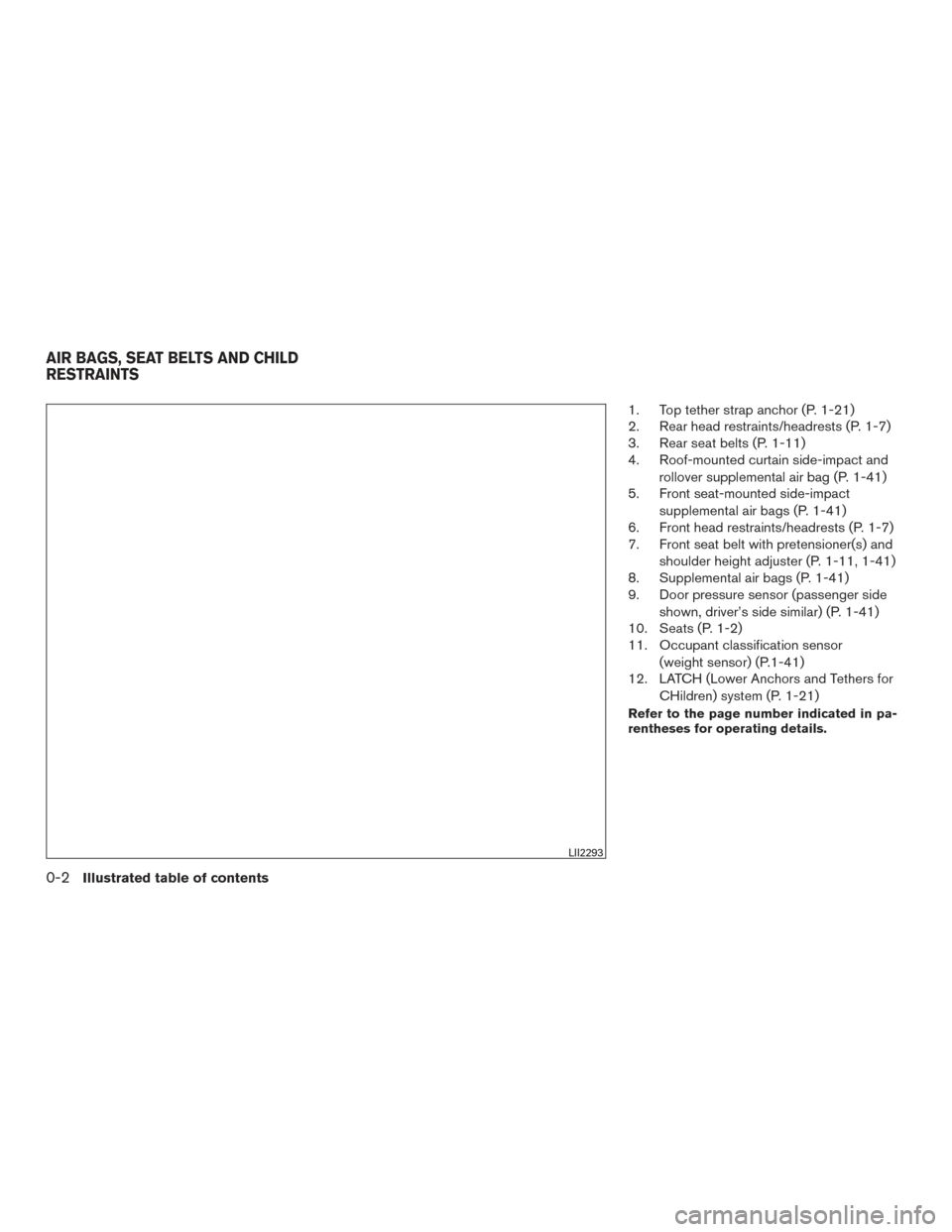
1. Top tether strap anchor (P. 1-21)
2. Rear head restraints/headrests (P. 1-7)
3. Rear seat belts (P. 1-11)
4. Roof-mounted curtain side-impact androllover supplemental air bag (P. 1-41)
5. Front seat-mounted side-impact
supplemental air bags (P. 1-41)
6. Front head restraints/headrests (P. 1-7)
7. Front seat belt with pretensioner(s) and
shoulder height adjuster (P. 1-11, 1-41)
8. Supplemental air bags (P. 1-41)
9. Door pressure sensor (passenger side
shown, driver’s side similar) (P. 1-41)
10. Seats (P. 1-2)
11. Occupant classification sensor
(weight sensor) (P.1-41)
12. LATCH (Lower Anchors and Tethers for
CHildren) system (P. 1-21)
Refer to the page number indicated in pa-
rentheses for operating details.
LII2293
AIR BAGS, SEAT BELTS AND CHILD
RESTRAINTS
0-2Illustrated table of contents
Page 12 of 406
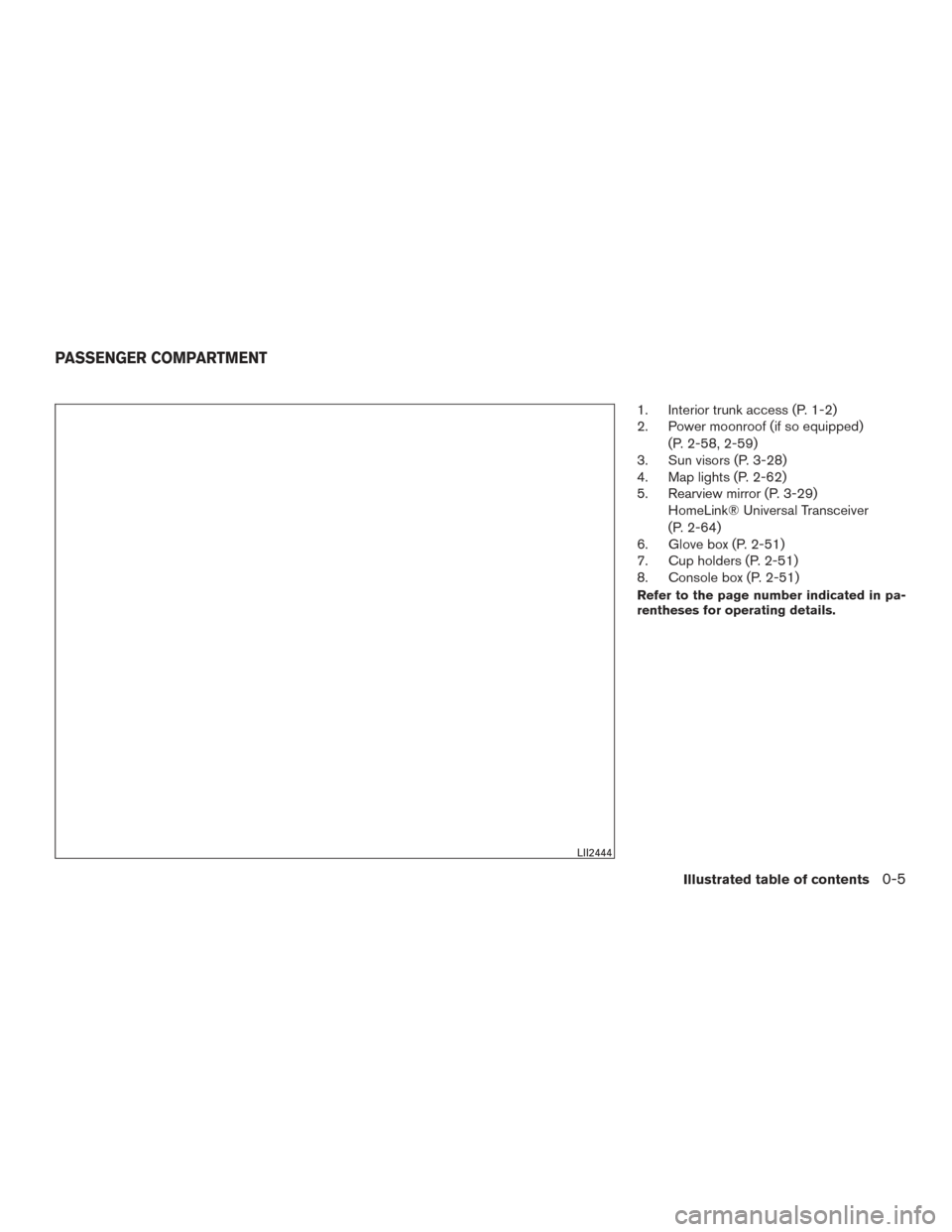
1. Interior trunk access (P. 1-2)
2. Power moonroof (if so equipped)(P. 2-58, 2-59)
3. Sun visors (P. 3-28)
4. Map lights (P. 2-62)
5. Rearview mirror (P. 3-29) HomeLink® Universal Transceiver
(P. 2-64)
6. Glove box (P. 2-51)
7. Cup holders (P. 2-51)
8. Console box (P. 2-51)
Refer to the page number indicated in pa-
rentheses for operating details.
LII2444
PASSENGER COMPARTMENT
Illustrated table of contents0-5
Page 58 of 406

PRECAUTIONS ON SRS
This SRS section contains important information
concerning the following systems:● Driver and front passenger supplemental
front-impact air bag (NISSAN Advanced Air
Bag System)
● Front seat-mounted side-impact supple-
mental air bag
● Roof-mounted curtain side-impact and roll-
over supplemental air bag
● Seat belt with pretensioner(s) (front seats)
Supplemental front-impact air bag system
The NISSAN Advanced Air Bag System can help
cushion the impact force to the head and chest of
the driver and front passenger in certain frontal
collisions.
Front seat-mounted side-impact supple-
mental air bag system
This system can help cushion the impact force to
the chest area of the driver and front passenger in
certain side-impact collisions. The side air bags
are designed to inflate on the side where the
vehicle is impacted. Roof-mounted curtain side-impact and
rollover supplemental air bag system
This system can help cushion the impact force to
the head of occupants in front and rear outboard
seating positions in certain side-impact colli-
sions. The curtain air bags are designed to inflate
on the side where the vehicle is impacted. In a
rollover, the curtain air bags are designed to
inflate and remain inflated for a short time.
The SRS is designed to
supplementthe crash
protection provided by the driver and front pas-
senger seat belts and is not a substitutefor
them. Seat belts should always be correctly worn
and the occupant seated a suitable distance
away from the steering wheel, instrument panel
and door finishers. For additional information
about instructions and precautions on seat belt
usage, refer to “Seat belts” in this section.
The supplemental air bags operate only
when the ignition switch is placed in the ON
position.
After placing the ignition switch in the ON
position, the supplemental air bag warning
light illuminates. The supplemental air bag
warning light will turn off after about 7 sec-
onds if the system is operational.
SUPPLEMENTAL RESTRAINT
SYSTEM (SRS)
Safety—Seats, seat belts and supplemental restraint system1-41
Page 63 of 406
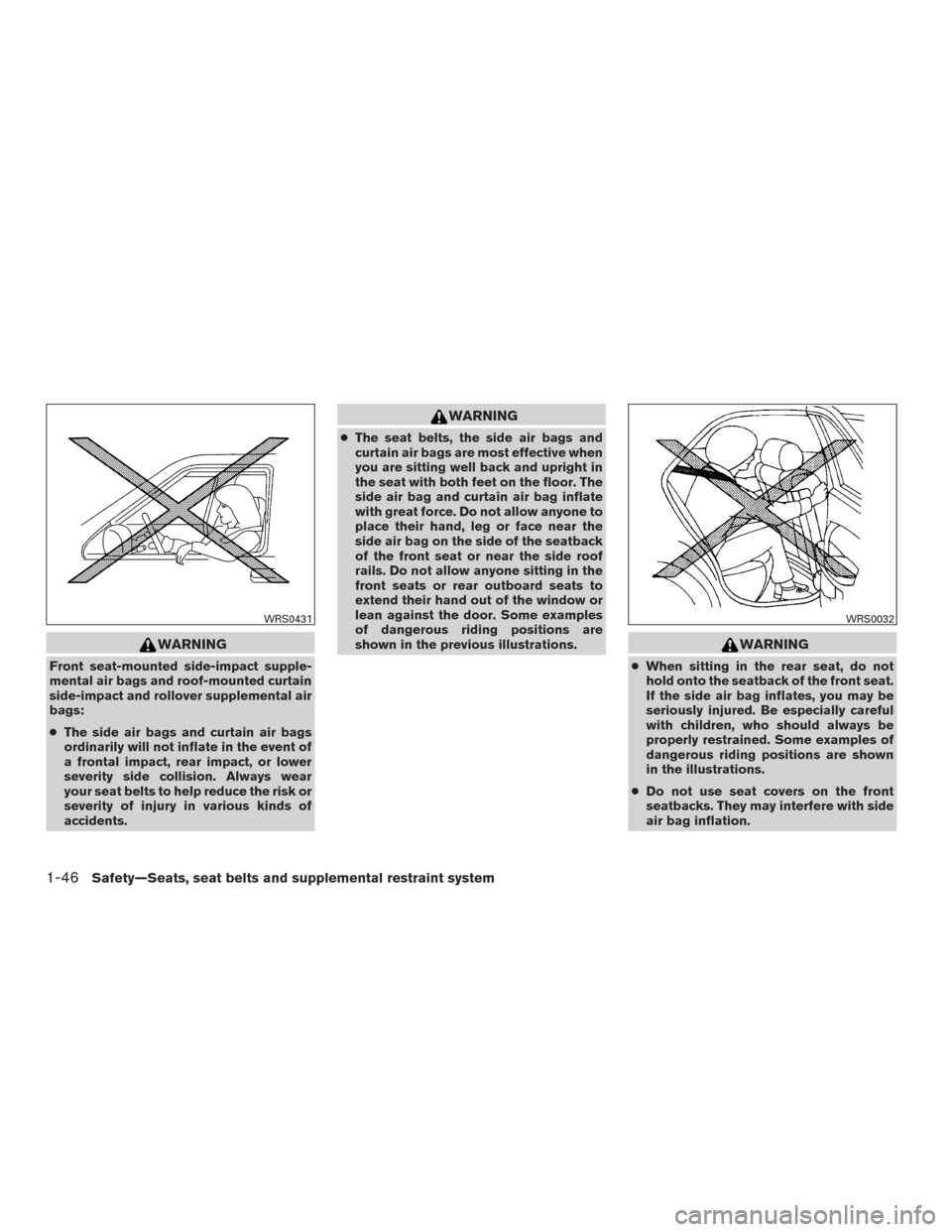
WARNING
Front seat-mounted side-impact supple-
mental air bags and roof-mounted curtain
side-impact and rollover supplemental air
bags:
●The side air bags and curtain air bags
ordinarily will not inflate in the event of
a frontal impact, rear impact, or lower
severity side collision. Always wear
your seat belts to help reduce the risk or
severity of injury in various kinds of
accidents.
WARNING
● The seat belts, the side air bags and
curtain air bags are most effective when
you are sitting well back and upright in
the seat with both feet on the floor. The
side air bag and curtain air bag inflate
with great force. Do not allow anyone to
place their hand, leg or face near the
side air bag on the side of the seatback
of the front seat or near the side roof
rails. Do not allow anyone sitting in the
front seats or rear outboard seats to
extend their hand out of the window or
lean against the door. Some examples
of dangerous riding positions are
shown in the previous illustrations.
WARNING
● When sitting in the rear seat, do not
hold onto the seatback of the front seat.
If the side air bag inflates, you may be
seriously injured. Be especially careful
with children, who should always be
properly restrained. Some examples of
dangerous riding positions are shown
in the illustrations.
● Do not use seat covers on the front
seatbacks. They may interfere with side
air bag inflation.
WRS0431WRS0032
1-46Safety—Seats, seat belts and supplemental restraint system
Page 65 of 406
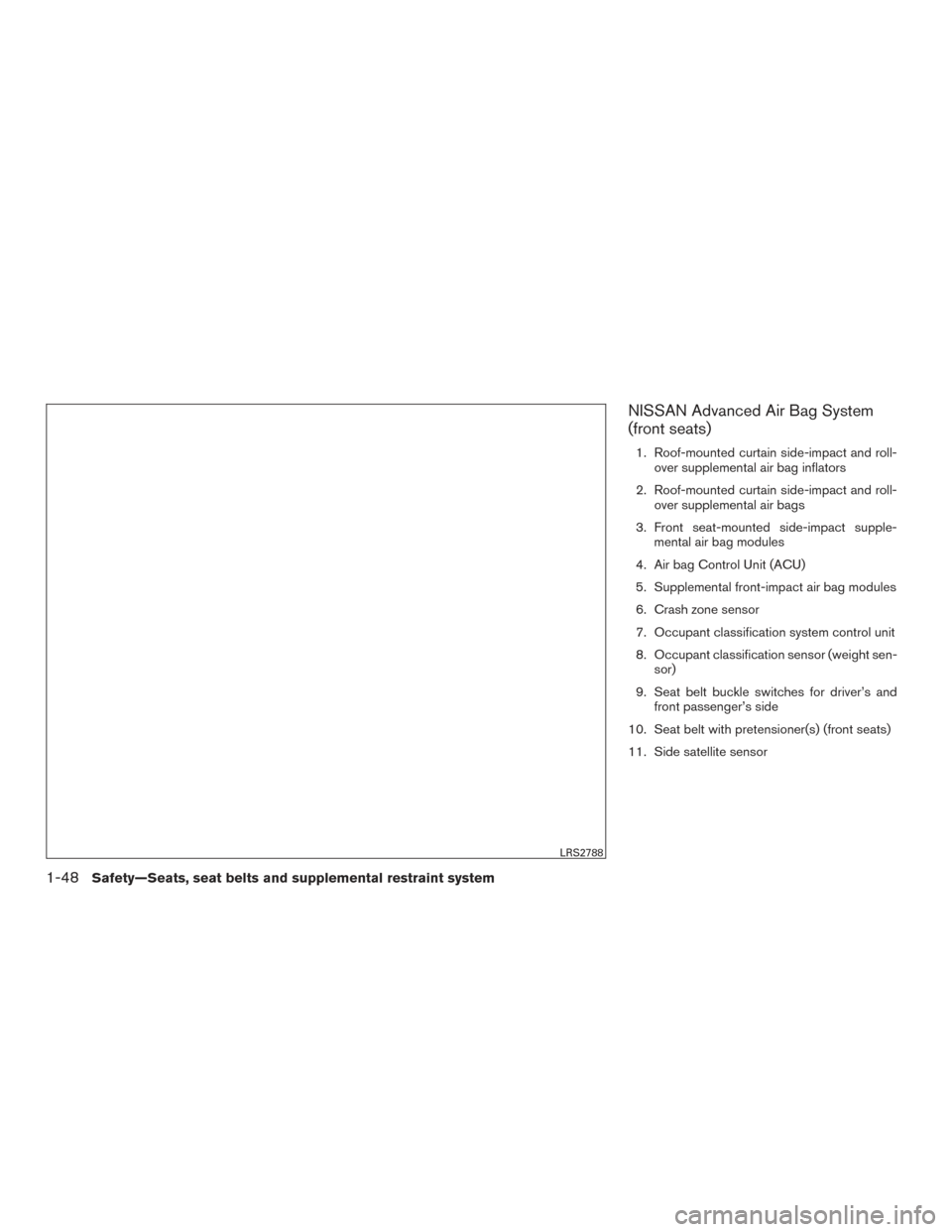
NISSAN Advanced Air Bag System
(front seats)
1. Roof-mounted curtain side-impact and roll-over supplemental air bag inflators
2. Roof-mounted curtain side-impact and roll- over supplemental air bags
3. Front seat-mounted side-impact supple- mental air bag modules
4. Air bag Control Unit (ACU)
5. Supplemental front-impact air bag modules
6. Crash zone sensor
7. Occupant classification system control unit
8. Occupant classification sensor (weight sen- sor)
9. Seat belt buckle switches for driver’s and front passenger’s side
10. Seat belt with pretensioner(s) (front seats)
11. Side satellite sensor
LRS2788
1-48Safety—Seats, seat belts and supplemental restraint system
Page 73 of 406

●No unauthorized changes should be
made to any components or wiring of
the seat belt system. This may affect the
front air bag system. Tampering with
the seat belt system may result in seri-
ous personal injury.
● It is recommended that you visit a
NISSAN dealer for work on and around
the front air bag. It is also recom-
mended that you visit a NISSAN dealer
for installation of electrical equipment.
The Supplemental Restraint System
(SRS) wiring harnesses* should not be
modified or disconnected. Unauthor-
ized electrical test equipment and prob-
ing devices should not be used on the
air bag system.
● A cracked windshield should be re-
placed immediately by a qualified repair
facility. A cracked windshield could af-
fect the function of the supplemental air
bag system.
*The SRS wiring harness connectors are
yellow and orange for easy identification.
When selling your vehicle, we request that you
inform the buyer about the front air bag system
and guide the buyer to the appropriate sections
in this Owner’s Manual.
Front seat-mounted side-impact
supplemental air bag and roof-
mounted curtain side-impact and
rollover supplemental air bag systems
The side air bags are located in the outside of the
seatback of the front seats. The curtain air bags
are located in the side roof rails in both rows. All
of the information, cautions and warnings
in this manual apply and must be followed.
The side air bags and curtain air bags are de-
signed to inflate in higher severity side collisions,
although they may inflate if the forces in another
type of collision are similar to those of a higher
severity impact. They are designed to inflate on the side where the vehicle is impacted. They may
not inflate in certain side collisions.
Curtain air bags are also designed to inflate in
certain types of rollover collisions or near roll-
overs. As a result, certain vehicle movements (for
example, during severe off-roading) may cause
the curtain air bags to inflate.
Vehicle damage (or lack of it) is not always an
indication of proper side air bag and curtain air
bag operation.
When the side air bags and curtain air bags
inflate, a fairly loud noise may be heard, followed
by release of smoke. This smoke is not harmful
and does not indicate a fire. Care should be taken
not to inhale it, as it may cause irritation and
choking. Those with a history of a breathing con-
dition should get fresh air promptly.
Side air bags, along with the use of seat belts,
help to cushion the impact force on the chest of
the front occupants. Curtain air bags help to
cushion the impact force to the head of occu-
pants in the front and rear outboard seating po-
sitions in all rows. They can help save lives and
reduce serious injuries. However, an inflating
side air bag or curtain air bag may cause abra-
sions or other injuries. Side air bags and curtain
air bags do not provide restraint to the lower
body.
LRS0259
1-56Safety—Seats, seat belts and supplemental restraint system
Page 74 of 406
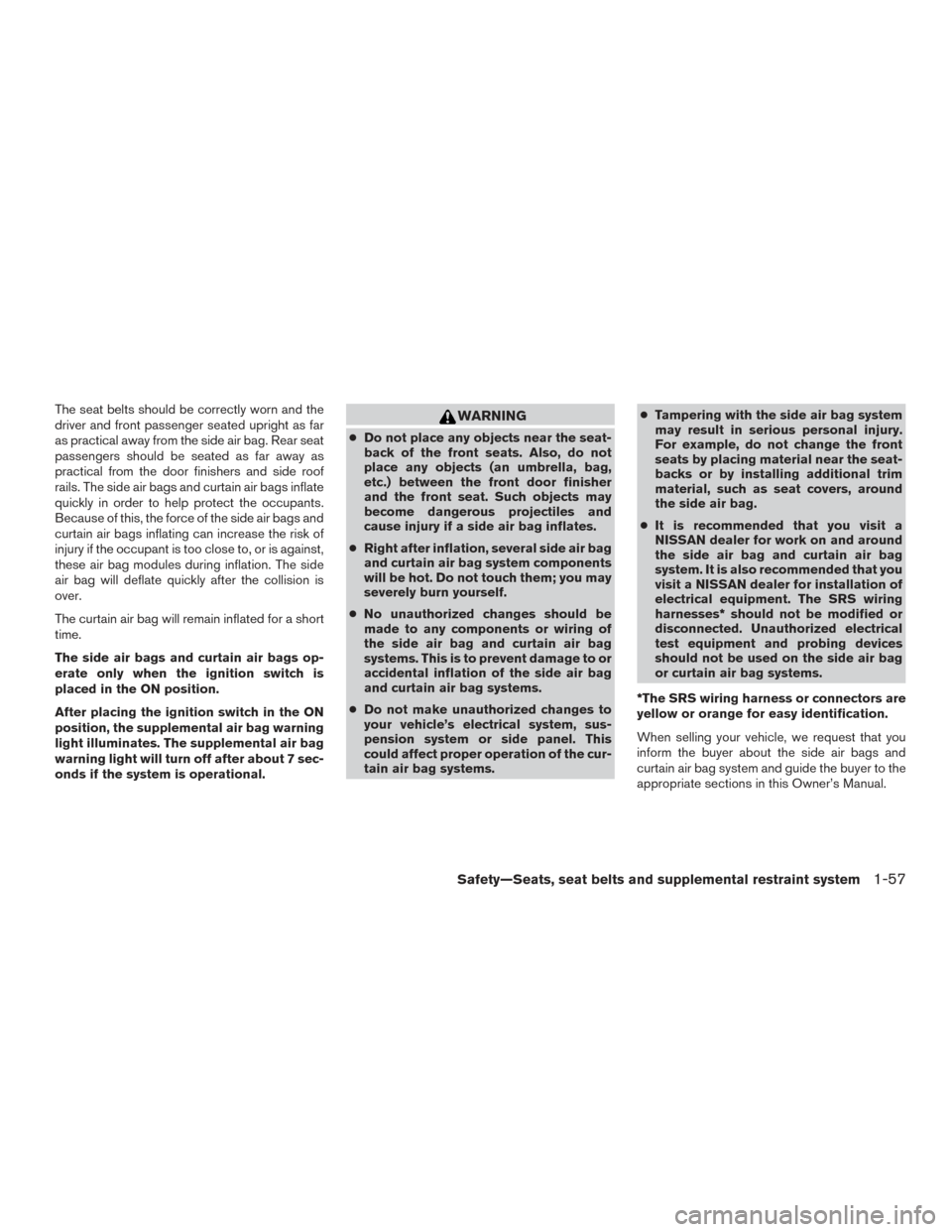
The seat belts should be correctly worn and the
driver and front passenger seated upright as far
as practical away from the side air bag. Rear seat
passengers should be seated as far away as
practical from the door finishers and side roof
rails. The side air bags and curtain air bags inflate
quickly in order to help protect the occupants.
Because of this, the force of the side air bags and
curtain air bags inflating can increase the risk of
injury if the occupant is too close to, or is against,
these air bag modules during inflation. The side
air bag will deflate quickly after the collision is
over.
The curtain air bag will remain inflated for a short
time.
The side air bags and curtain air bags op-
erate only when the ignition switch is
placed in the ON position.
After placing the ignition switch in the ON
position, the supplemental air bag warning
light illuminates. The supplemental air bag
warning light will turn off after about 7 sec-
onds if the system is operational.WARNING
●Do not place any objects near the seat-
back of the front seats. Also, do not
place any objects (an umbrella, bag,
etc.) between the front door finisher
and the front seat. Such objects may
become dangerous projectiles and
cause injury if a side air bag inflates.
● Right after inflation, several side air bag
and curtain air bag system components
will be hot. Do not touch them; you may
severely burn yourself.
● No unauthorized changes should be
made to any components or wiring of
the side air bag and curtain air bag
systems. This is to prevent damage to or
accidental inflation of the side air bag
and curtain air bag systems.
● Do not make unauthorized changes to
your vehicle’s electrical system, sus-
pension system or side panel. This
could affect proper operation of the cur-
tain air bag systems. ●
Tampering with the side air bag system
may result in serious personal injury.
For example, do not change the front
seats by placing material near the seat-
backs or by installing additional trim
material, such as seat covers, around
the side air bag.
● It is recommended that you visit a
NISSAN dealer for work on and around
the side air bag and curtain air bag
system. It is also recommended that you
visit a NISSAN dealer for installation of
electrical equipment. The SRS wiring
harnesses* should not be modified or
disconnected. Unauthorized electrical
test equipment and probing devices
should not be used on the side air bag
or curtain air bag systems.
*The SRS wiring harness or connectors are
yellow or orange for easy identification.
When selling your vehicle, we request that you
inform the buyer about the side air bags and
curtain air bag system and guide the buyer to the
appropriate sections in this Owner’s Manual.
Safety—Seats, seat belts and supplemental restraint system1-57
Page 80 of 406

Power outlet..................................... 2-50
Extended storage switch .......................... 2-50
Storage ......................................... 2-51
Map pockets .................................. 2-51
Seatback pockets ............................. 2-52
Storage tray .................................. 2-52
Glove box .................................... 2-53
Console box .................................. 2-53
Sunglasses holder ............................. 2-53
Cup holders .................................. 2-54
Windows ........................................ 2-55
Power windows ............................... 2-55
Moonroof (if so equipped) ......................... 2-58
Power moonroof ............................... 2-58
Dual Panel Moonroof (if so equipped) ...............2-59
Power moonroof ............................... 2-59Rear power sunshade (if so equipped)
..............2-61
Interior lights ..................................... 2-62
Console light .................................. 2-63
Map lights .................................... 2-63
Personal lights ................................ 2-64
Trunk light ....................................... 2-64
HomeLink® Universal Transceiver ..................2-64
Programming HomeLink® ......................2-65
Programming HomeLink® for Canadian
customers and gate openers ....................2-66
Operating the HomeLink® Universal
Transceiver ................................... 2-67
Programming trouble-diagnosis .................2-67
Clearing the programmed information ............2-67
Reprogramming a single HomeLink® button ......2-68
If your vehicle is stolen ......................... 2-68